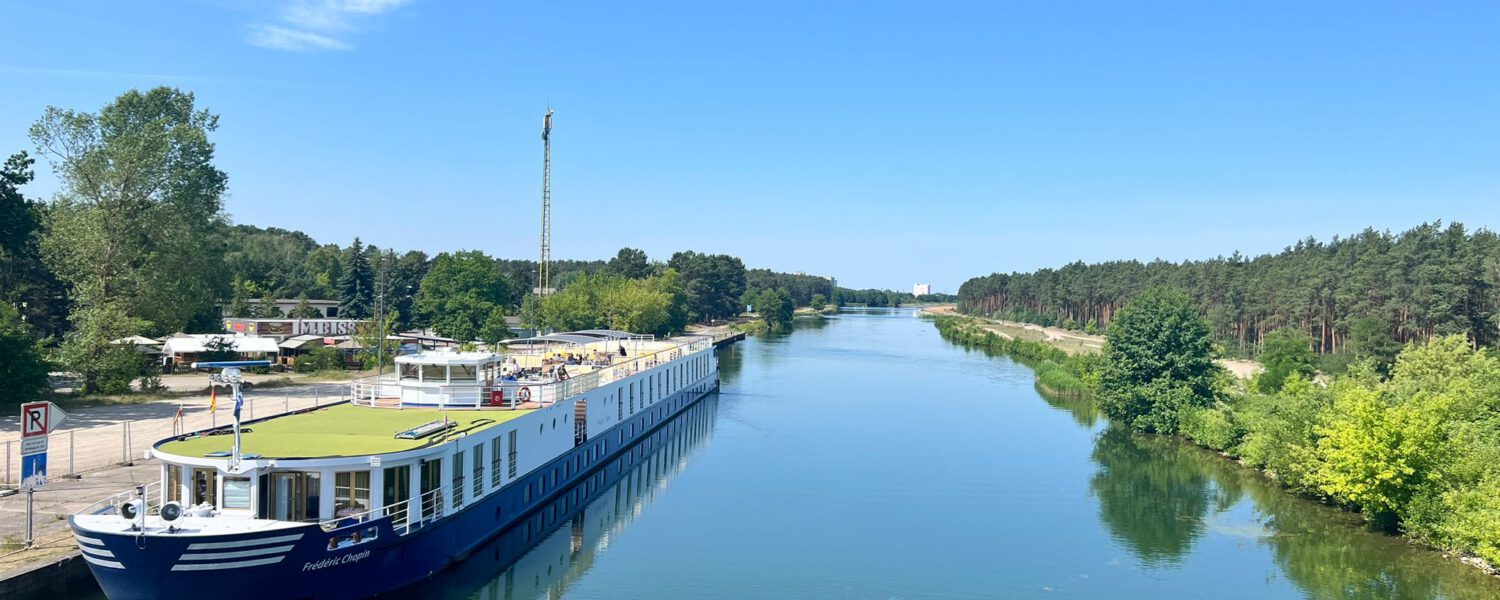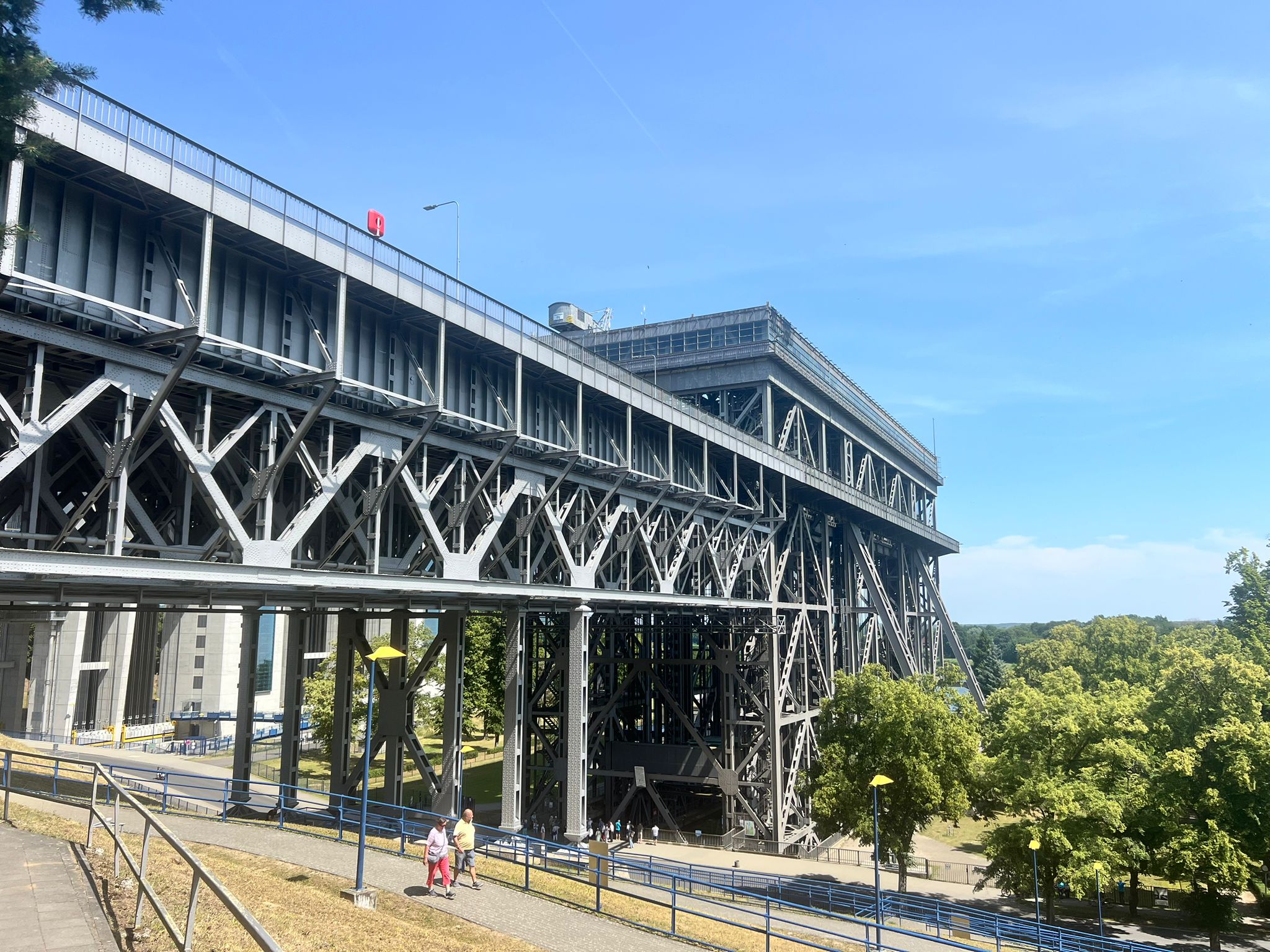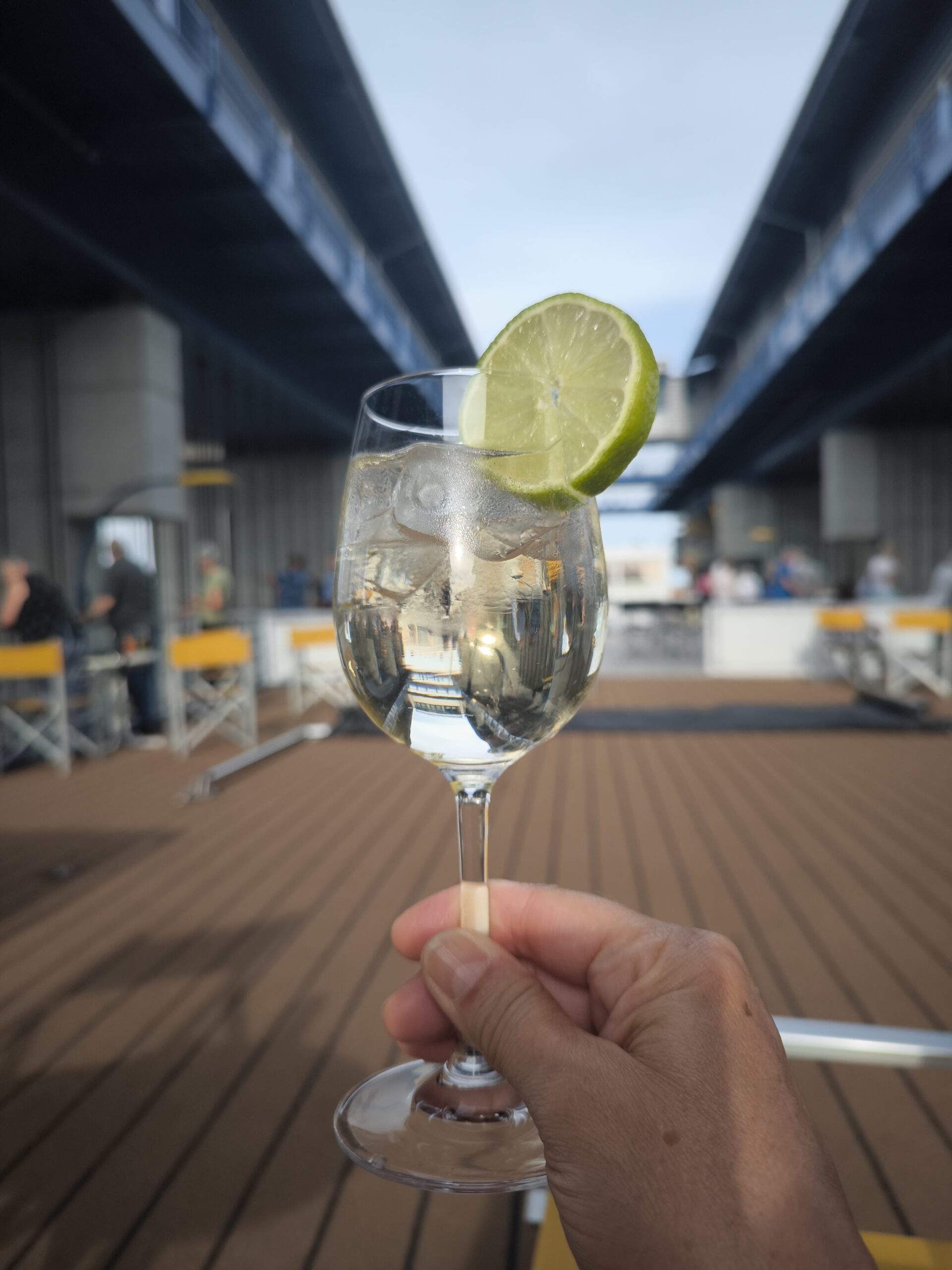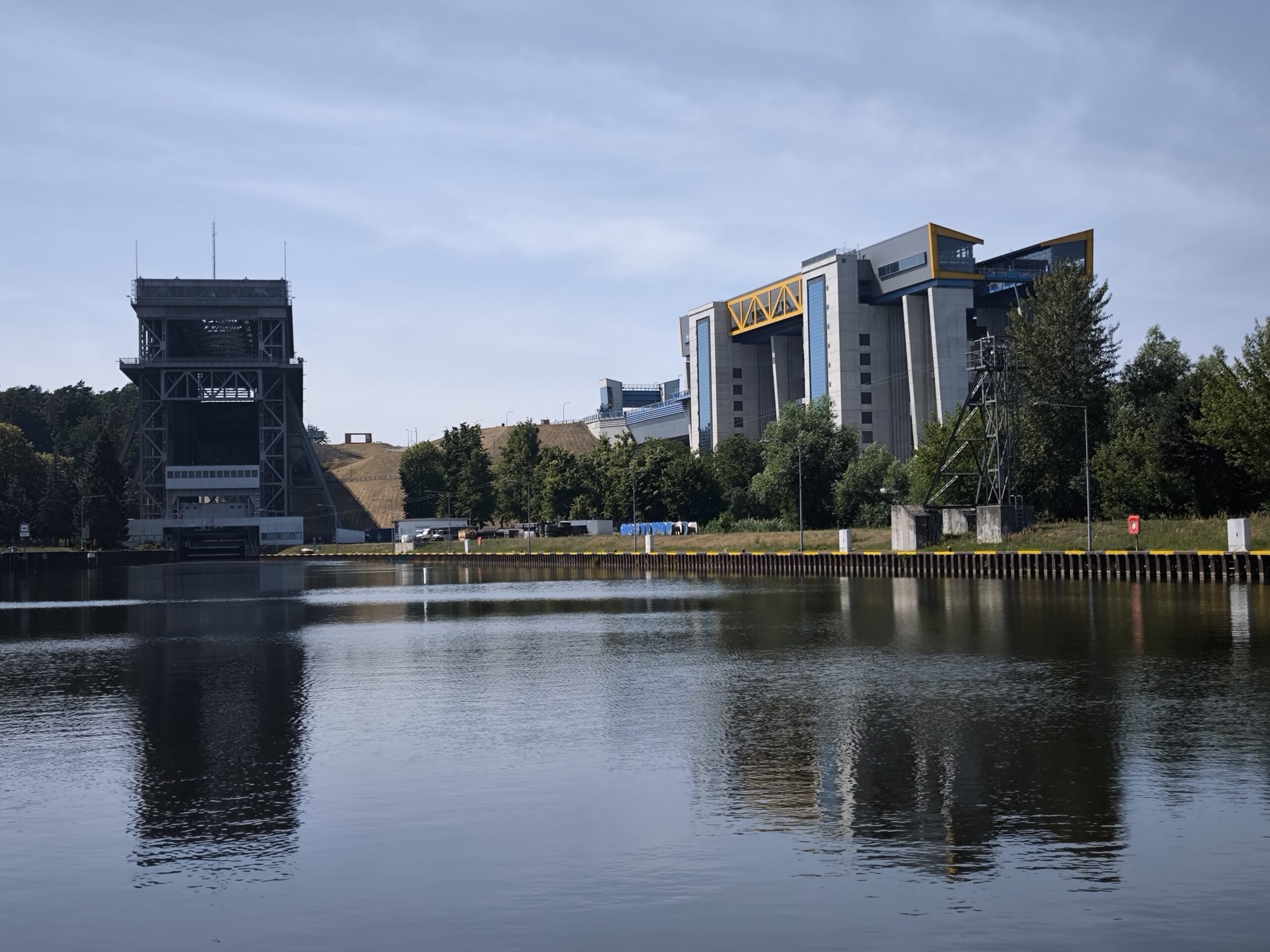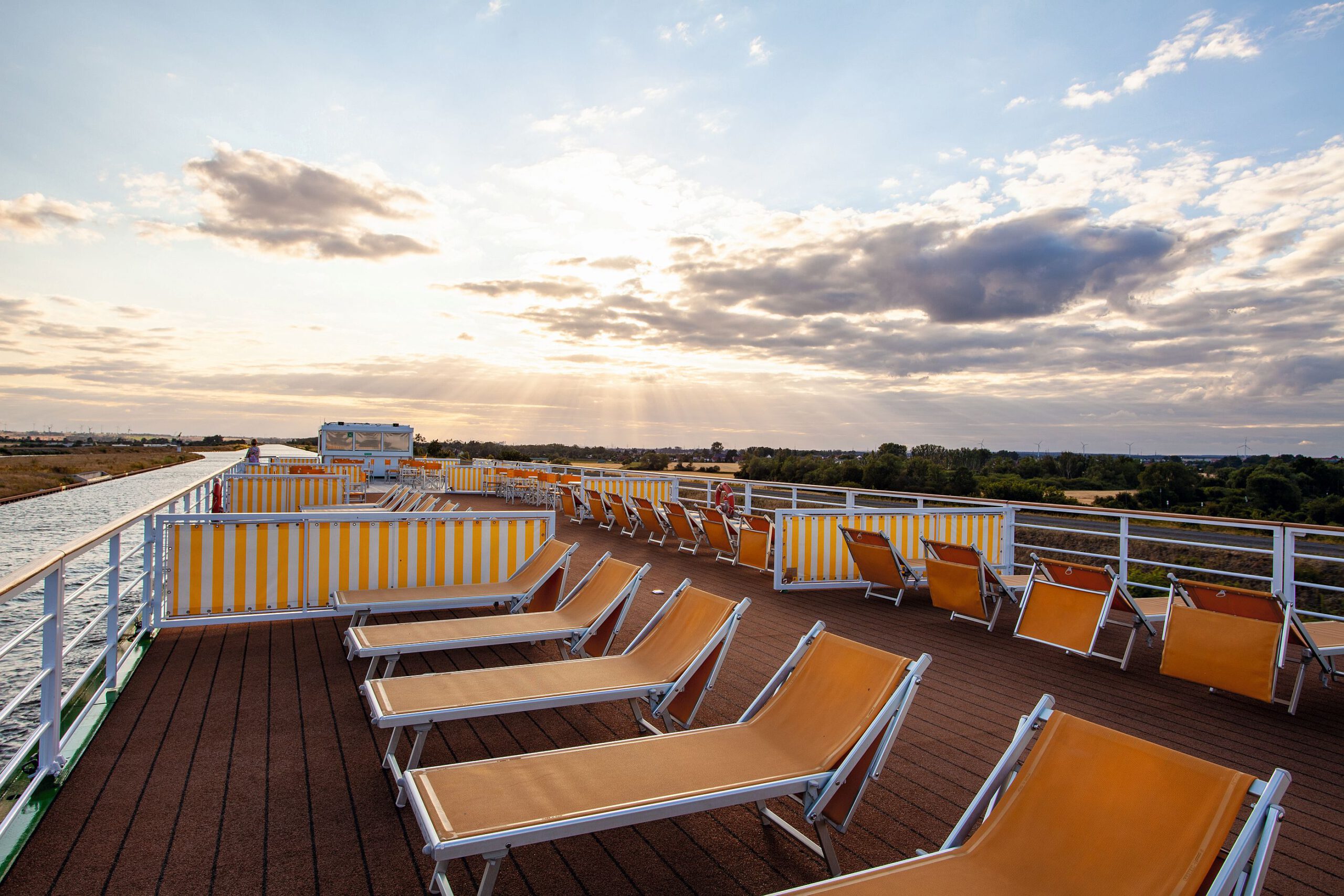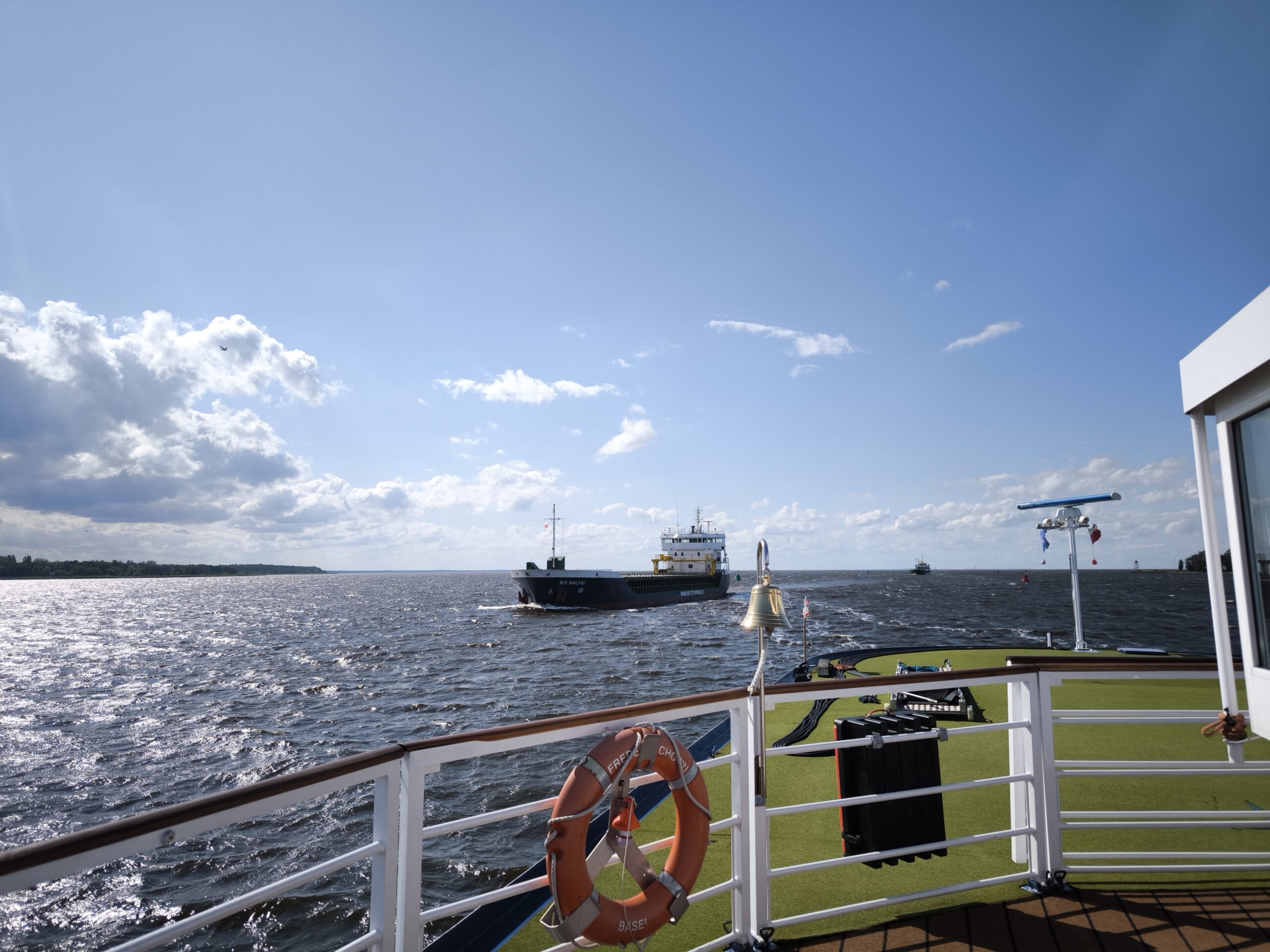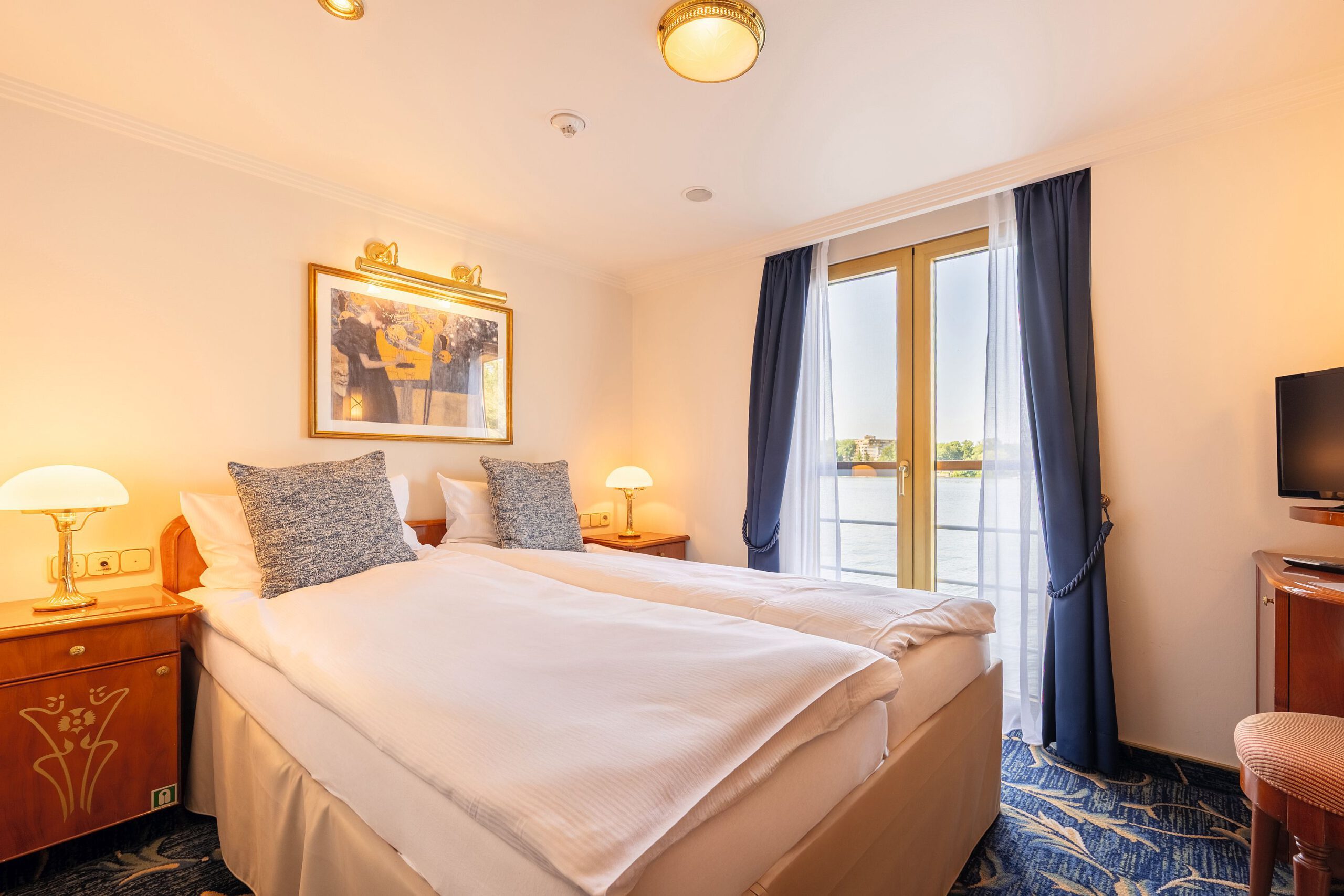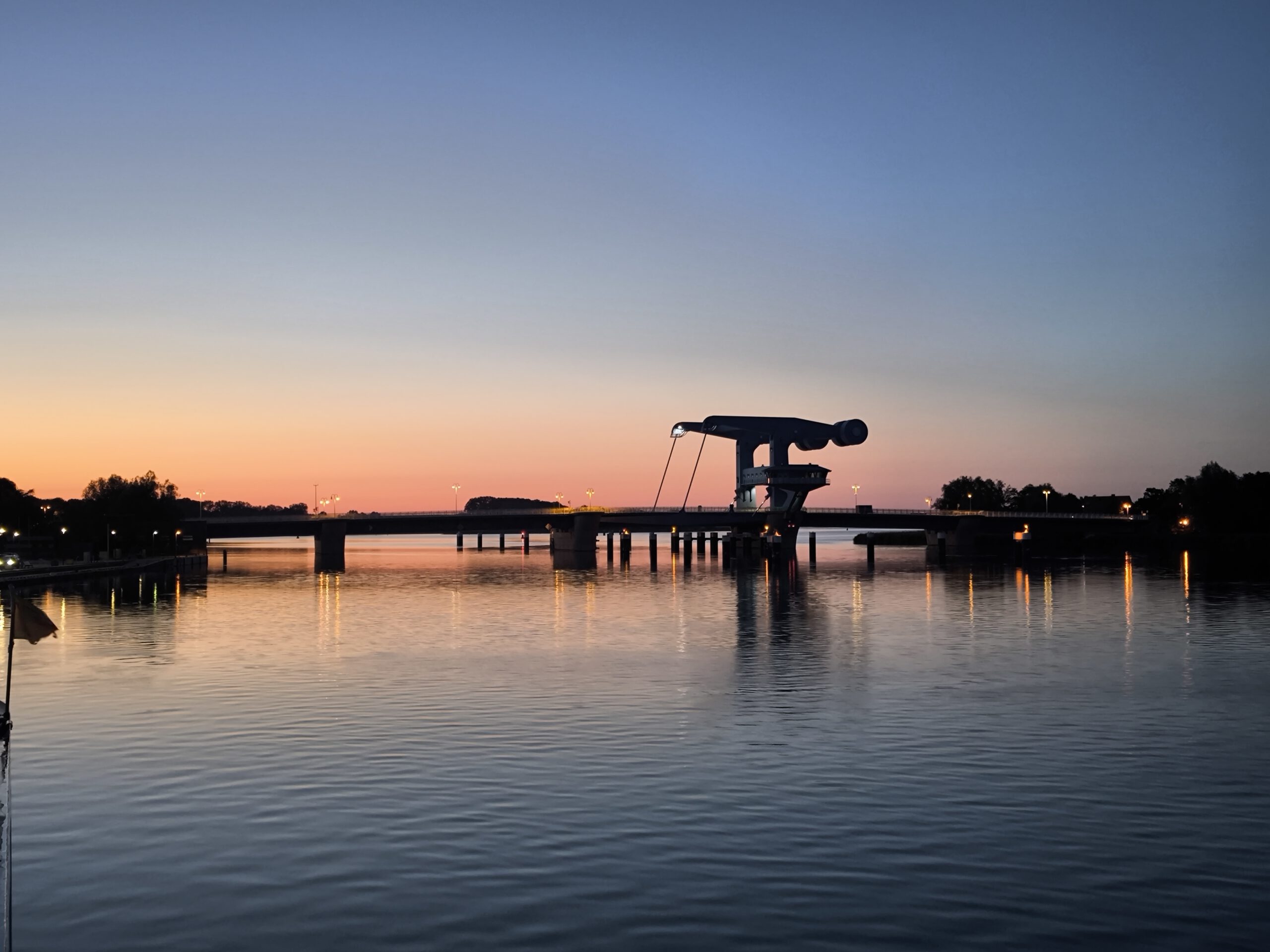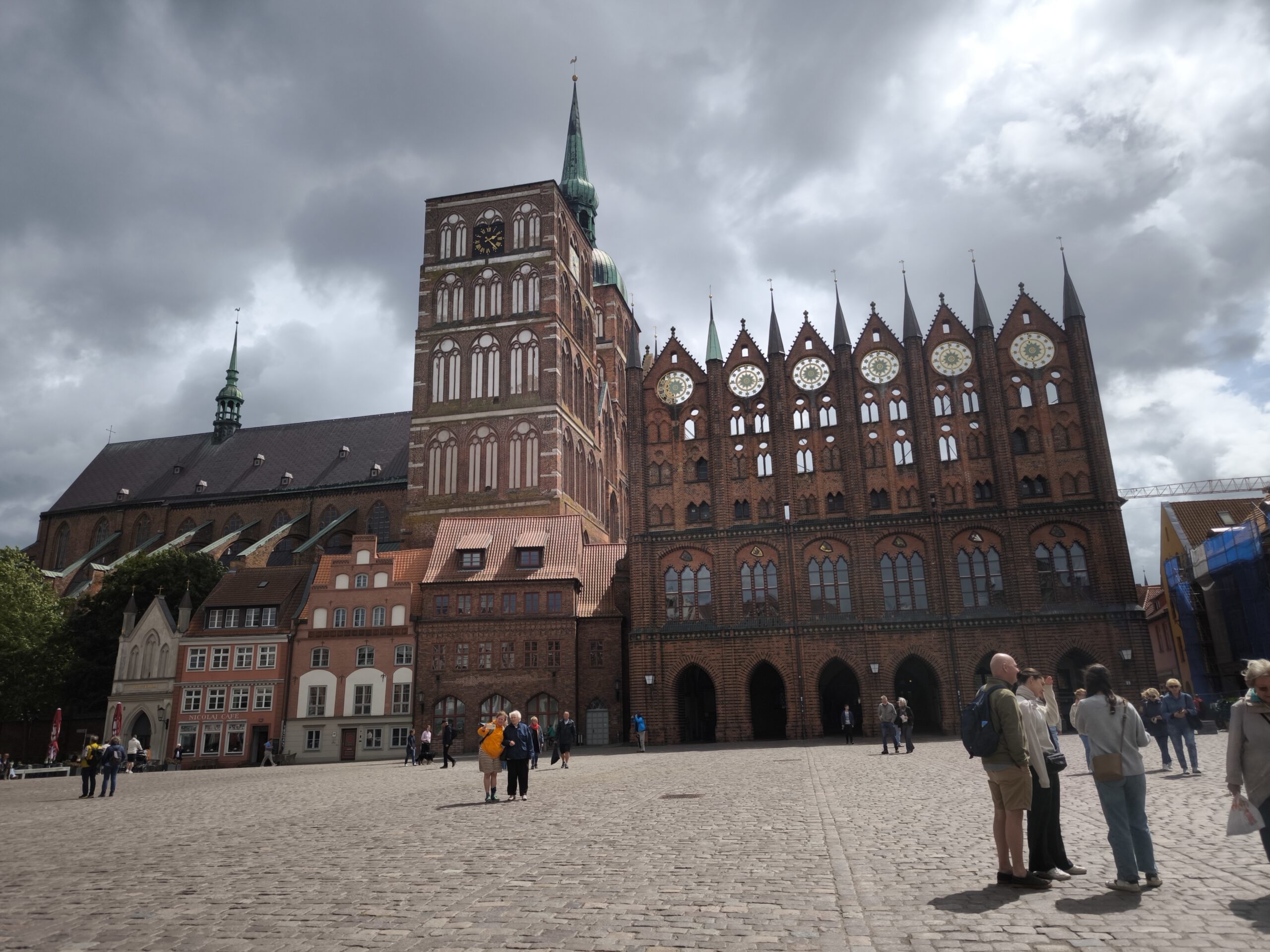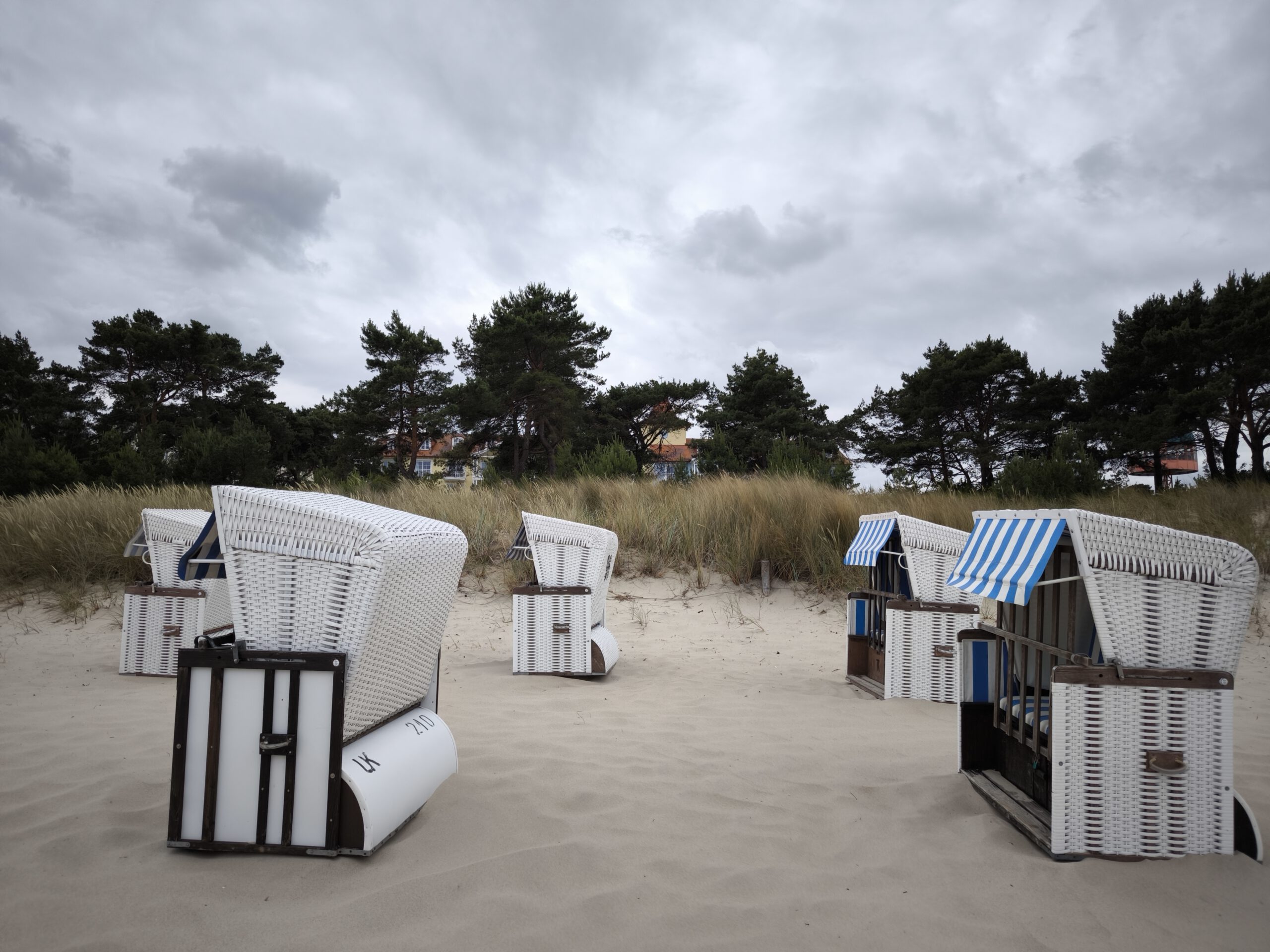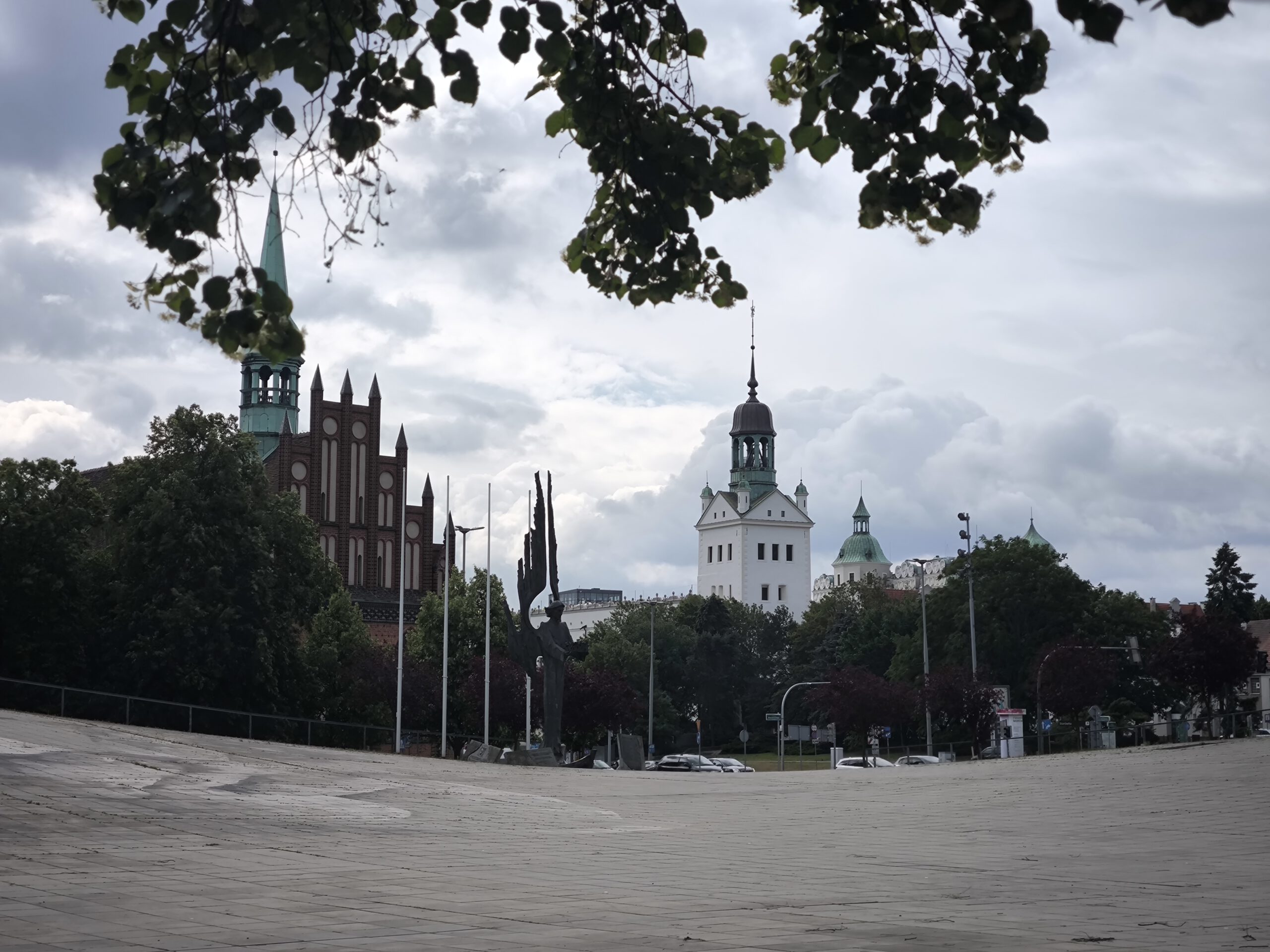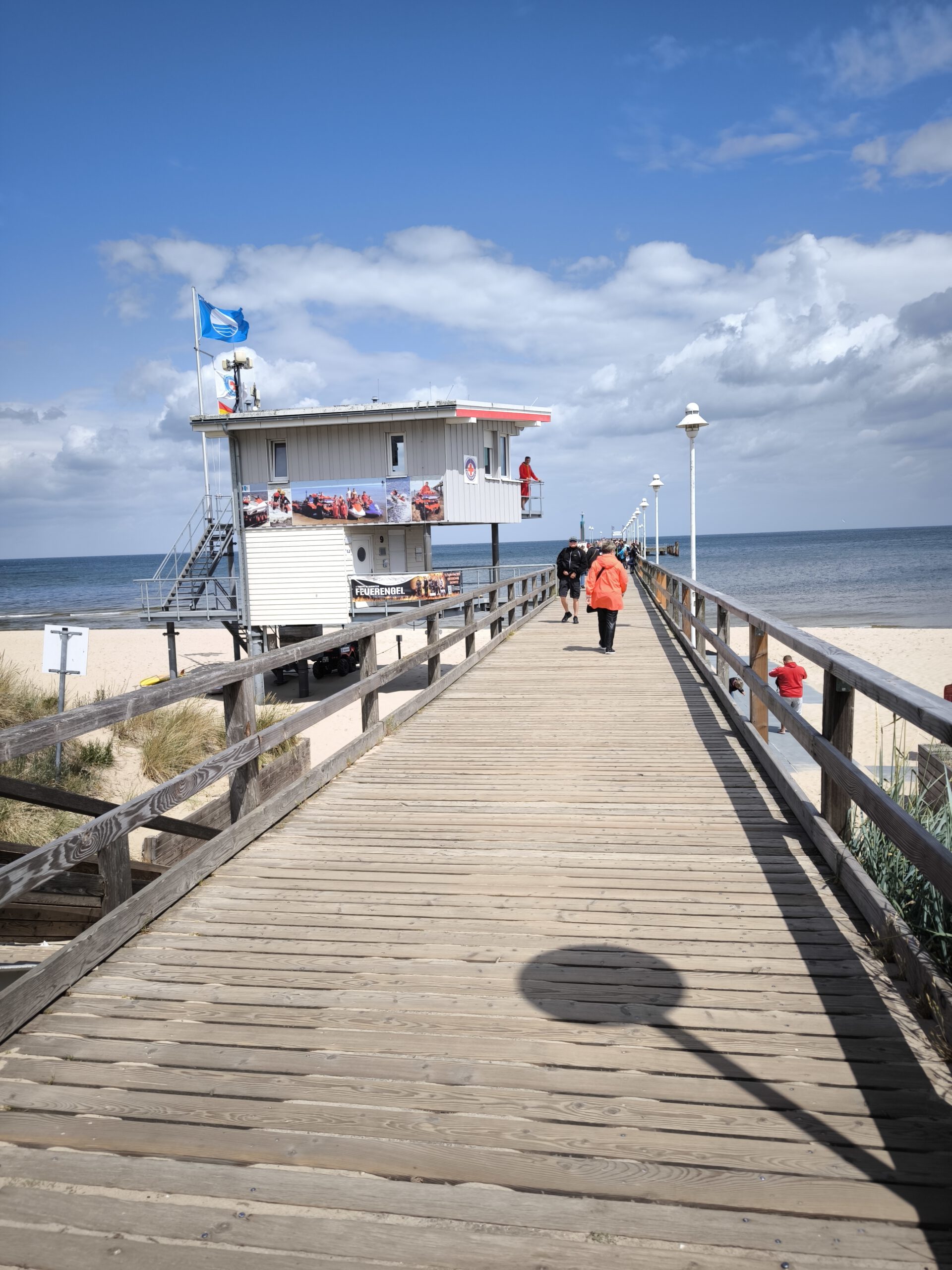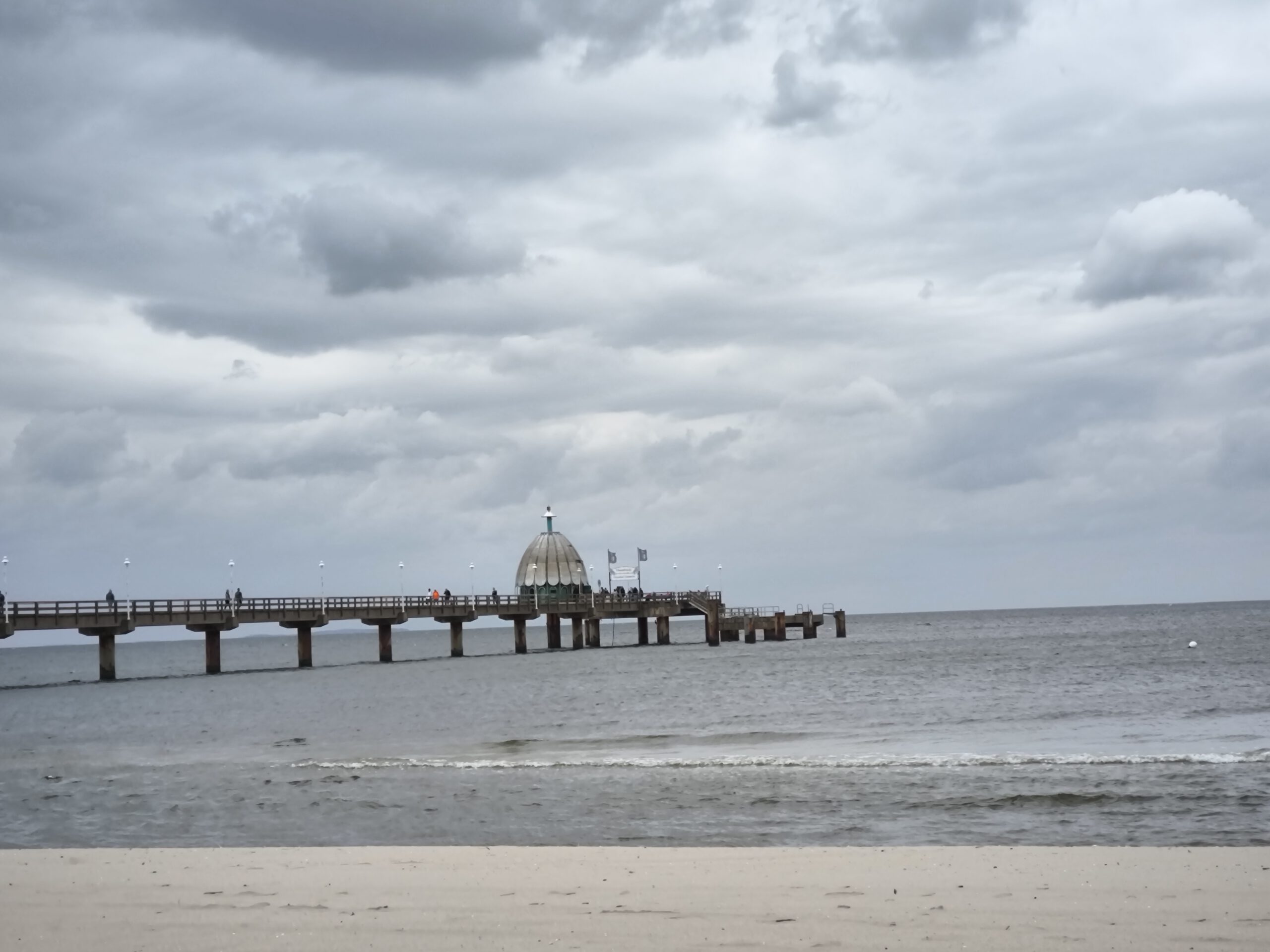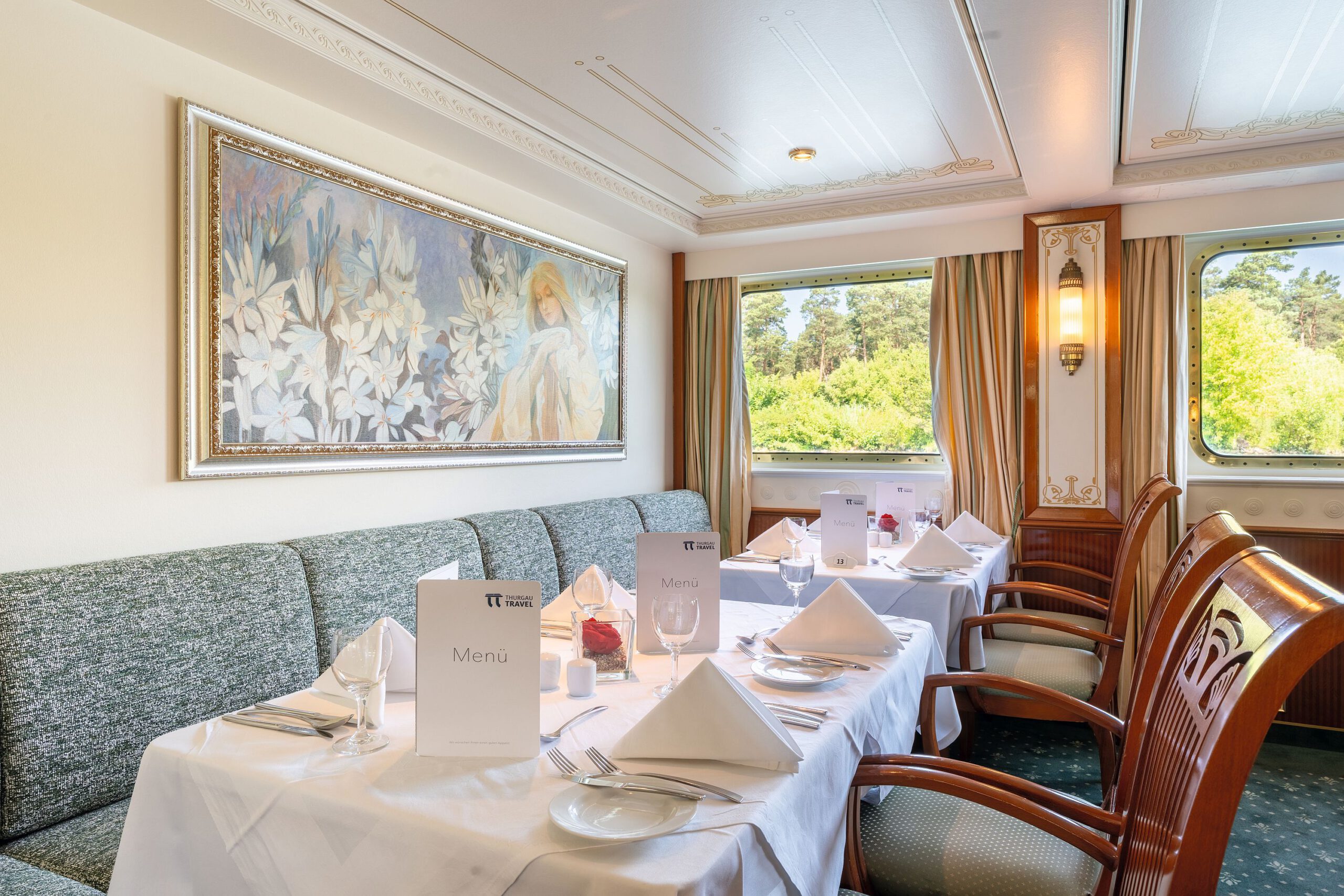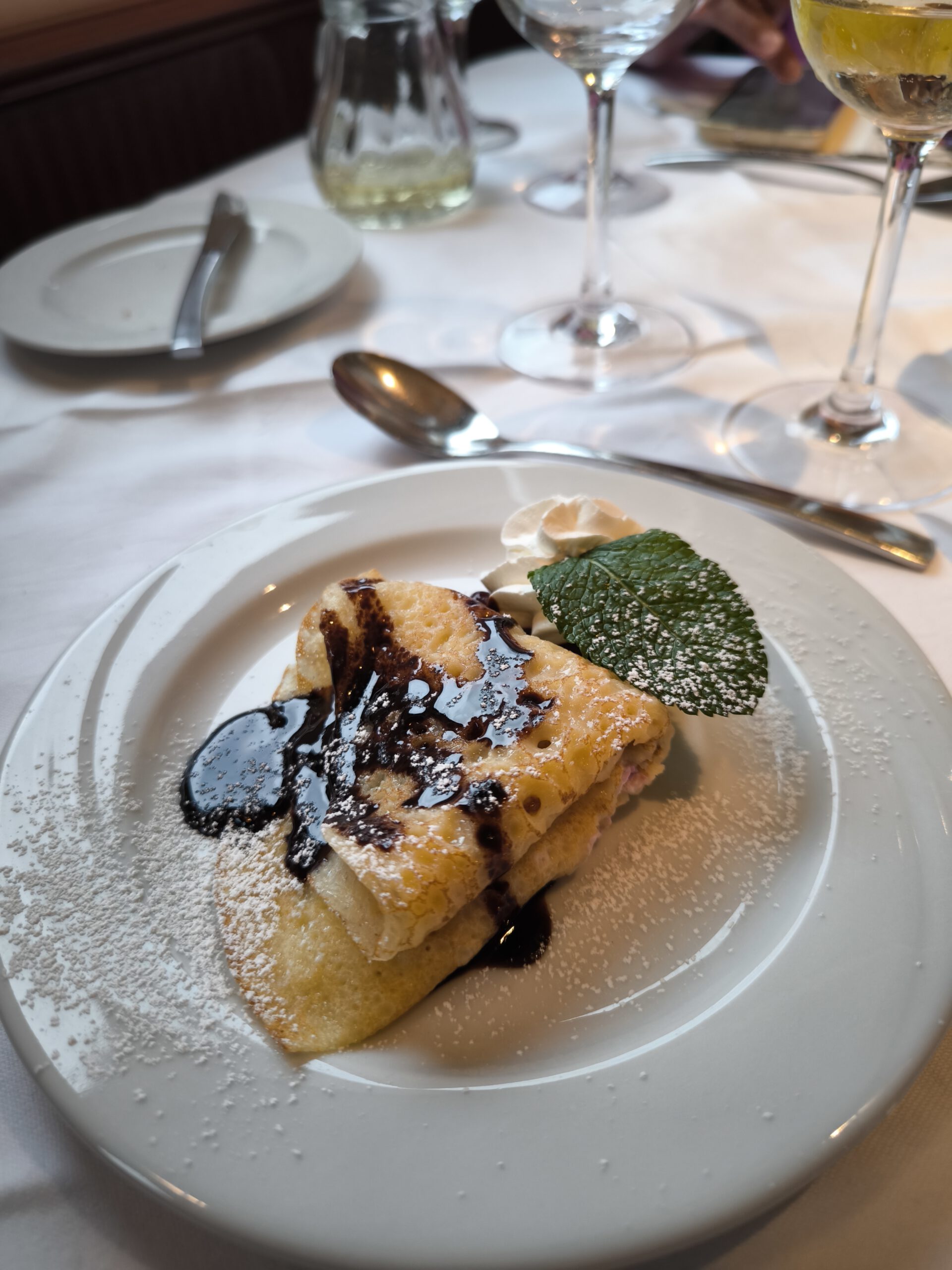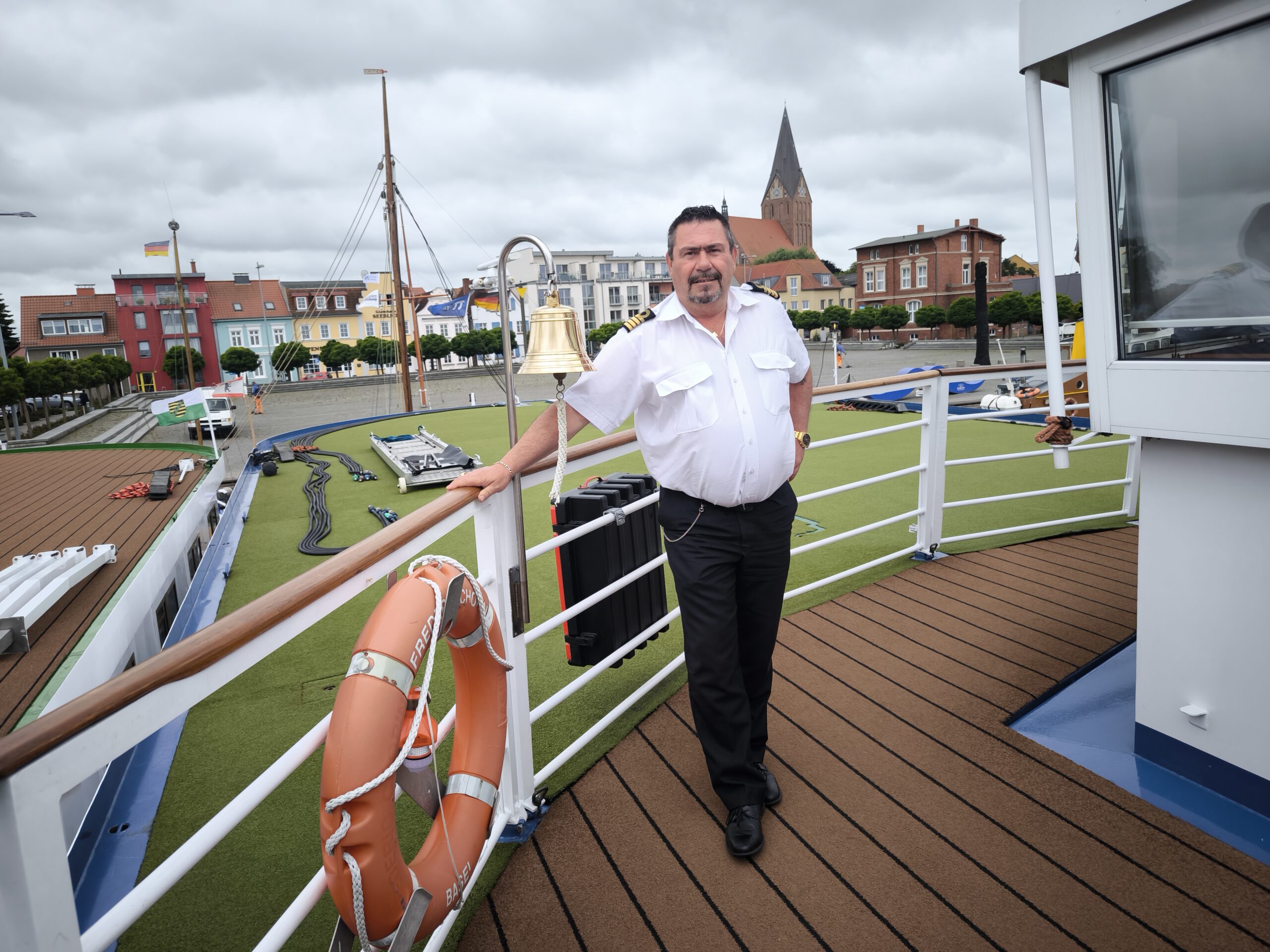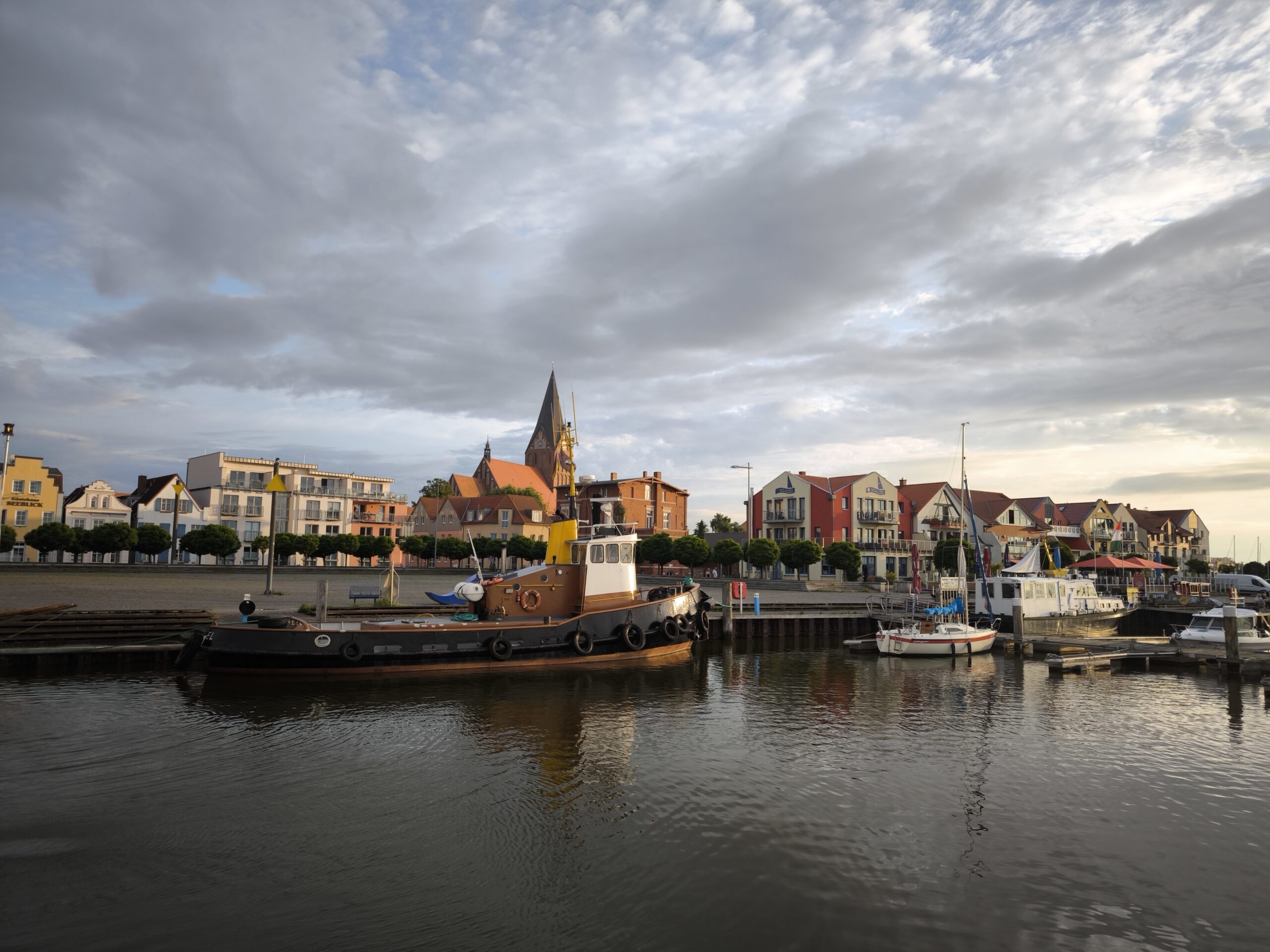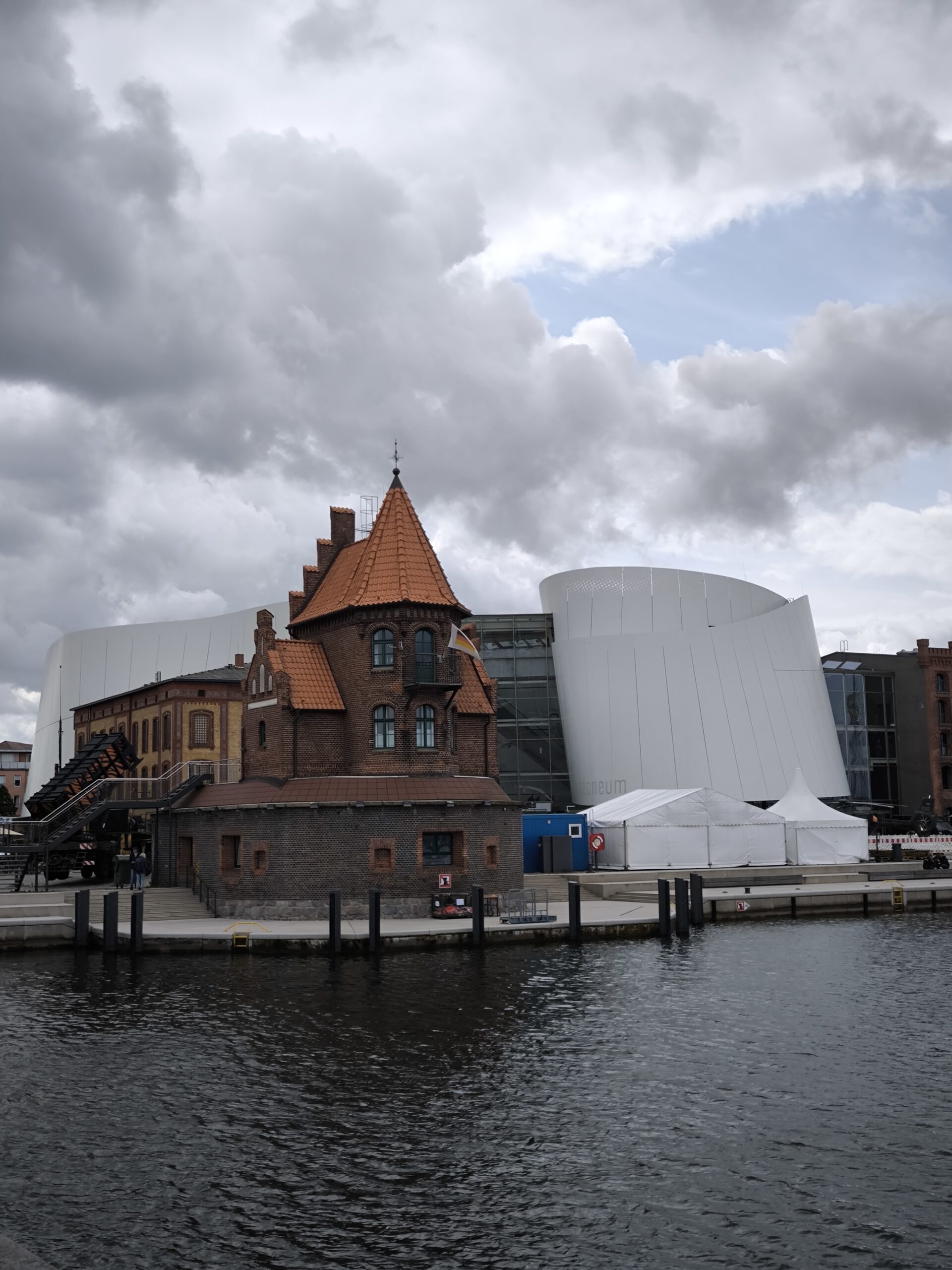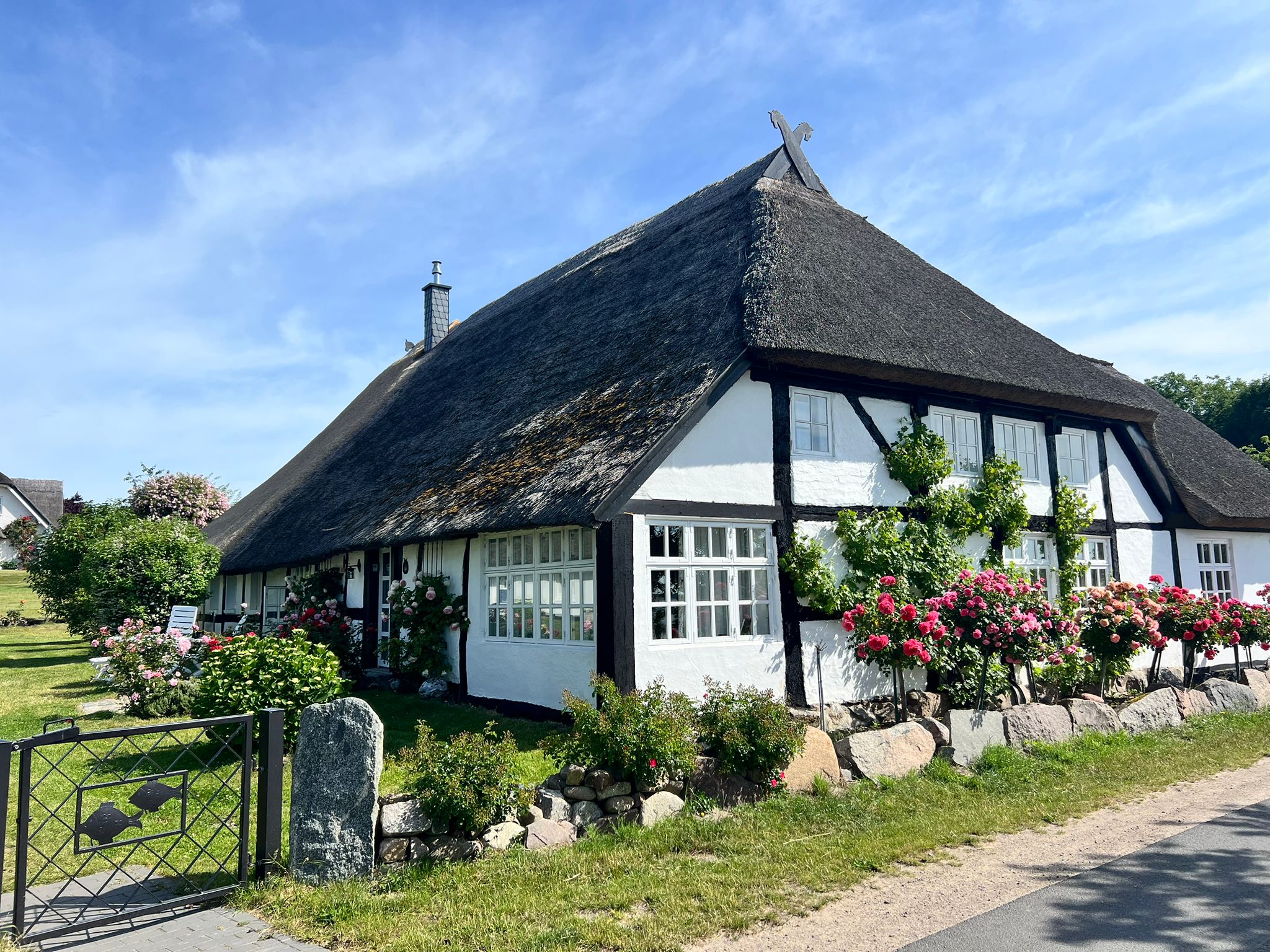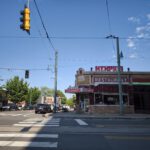
Between blues and BBQ: On the road in Memphis
28. September 2025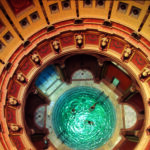
Deluxe time out at the Steigenberger Icon Europäischer Hof Baden-Baden
26. October 2025On the waves of the Szczecin Lagoon
From the metropolis to the green landscape of the Havel and Oder rivers, to the Szczecin Lagoon and the Baltic Sea: the river cruise from Berlin to Stralsund delights with its wide-open nature, piers, beaches and brick-built romanticism.
Lake Tegel on a sunny weekend: sailing boats and excursion ships are out on the water. Stand-up paddlers and air mattresses criss-cross between them. On the shore, the capital's residents sit on café terraces with a ‘Berliner Weiße’. They enjoy the warm weather on the second-largest lake in the German capital in the district of Tegel. The MS Chopin is moored on the tree-shaded Greenwich Promenade. The 83-metre-long river cruise ship shares the jetty here with party boats such as the Moby Dick and the Havel Queen.
Around 70 passengers – mainly Swiss, with a few Germans and Austrians – have booked the week-long tour from Berlin to Stralsund. At around 6 p.m., it's time to cast off and we leave Berlin by water. Everyone is sitting on the sun deck as Captain Jaro Weinstein manoeuvres the ship across the busy lake and shortly afterwards into the Havel. After just a few hundred metres, even the last high-rise buildings have disappeared behind the trees and there is no longer any reminder of the big city. The river meanders through a green idyll with reeds swaying in the wind and large willows on the banks. Only interrupted by villas, beer gardens and marinas. The smell of barbecued food wafts through the air and party groups wave to us cheerfully. After the Lehnitz lock, the landscape opens up picturesquely into flat land and fields. The Havel is straightened here and the MS Chopin enters the Oder-Havel Canal at Kreuzbruch. The ship moors overnight in Eberswalde – a natural oasis in the Brandenburg countryside. Only birdsong, the humming of insects and the occasional flapping of wings from a heron taking flight can be heard through the open cabin window.
The next morning, a dozen athletic passengers are ready to set off on their e-bikes. They booked the cruise as a cycling holiday. ‘We enjoy cycling on the flat paths and the wide open countryside. We don't have that at home,’ says one of the Swiss passengers. A bicycle guide is on board especially for this purpose. He cycles with the group to Chorin Abbey, continues via the Niederfinow boat lift and back along the old Finow Canal.
Since 1258, the Cistercian abbey of Chorin has stood in the middle of the forest as a pearl of brick Gothic architecture and is now a ruin with a cemetery. The monastery backdrop has served as a filming location on several occasions – from GDR spy films to Amazon Prime series.
A few kilometres further on, the cyclists reach the Finow Canal. The historic, 420-year-old waterway delights with its picturesque scenery of water lilies between the reeds and mighty trees.
Back on the MS Chopin, we hurry to the deck so as not to miss the next highlight. We enter the new Niederfinow ship lift, which has been in operation since 2022 and is located right next to the old ship lift (in operation since 1934). All ships – from excursion boats to giant container ships – manoeuvre into a kind of bathtub here and are transported up or down like in a lift. In just a few minutes, they overcome the 36-metre difference in level between the Havel and Oder rivers.
Ship lifts are rare: there are only three in Germany. These two in Brandenburg and one on the Elbe near Lüneburg.
- Exciting passage: the old ship lift in Niederfinow
- Cheers to a wonderful cruise on the MS Chopin from Berlin to Stralsund
- The new and old ship lift in Niederfinow
Continuing on its way to Szczecin in Poland, the MS Chopin glides along the Old Oder and, from Hohensaaten, through the Lower Oder Valley National Park, which was founded in 1995 and covers a length of around 60 kilometres. A nature park ranger is on board and talks about this green paradise, which lies less than half a metre above sea level on the river that has formed the border between Germany and Poland since 1945. Polder meadows and peat islands glide by. In between, swans, geese and ducks swim on the water. In autumn, according to the ranger, around 15,000 cranes seek their roosts here. Beavers and otters are also native to the area. Meanwhile, the cycling group rides along the Oder dyke parallel to the MS Chopin and, thanks to e-bike ‘turbo’, arrives in Schwedt faster than the leisurely gliding river cruiser.
Schwedt an der Oder juts into the national park like a wedge and is one of the largest oil processing sites in Europe. We pass industrial chimneys, tank farms and pipelines, only to see large tobacco fields and drying barns shortly afterwards. During the GDR era, this was Germany's third-largest tobacco-growing region after the Palatinate and Baden, and even today the plant is still cultivated on several hectares.
Shortly afterwards, the Chopin makes a large loop into the heart of Szczecin, the capital of West Pomerania. Not far from the Dukes' Castle and the Chroby Ramparts, the captain moors at the waterfront promenade.
First, explore the city: all passengers go on a sightseeing tour. Numerous historic buildings were rebuilt in Szczecin after the Second World War. The Old Town Hall is surrounded by reconstructed town houses, including the birthplace of Alfred Döblin (1878-1957). Wide boulevards, squares with splashing fountains and large parks – strolling through the city is fun, and shopping queens are also in luck.
Meanwhile, a strong wind is blowing and rain showers are falling from the sky. Captain Weinstein has to make an announcement that is not uncommon. A storm with wind force eight is raging on the lagoon. That is too much for a river cruise ship. ‘We can sail up to force six under certain circumstances, but only if the wind is not coming from the side and pushing us out of the fairway,’ says the 60-year-old Czech.
The Szczecin Lagoon, a large lagoon sealed off from the Baltic Sea by the islands of Usedom and Wolin, is barely four metres deep and can only be navigated by larger ships via a dredged channel. "The water level hardly changes in the lagoon. It's not like other rivers. But the wind and the sandbanks are the problem. They shift and the channel has to be readjusted,‘ explains the captain, adding, ’Safety comes first. I am responsible for the passengers, crew and ship."
So we stay in Szczecin for one more night and visit Usedom by bus. In Wolgast, we cross the ‘Das blaue Wunder’ bascule bridge to Koserow and the seaside resort of Zinnowitz. There isn't much time to explore the island. But we do have time to walk across the pier to the diving gondola, eat a fish sandwich in a beach chair and take a dip in the Baltic Sea.
Back on board, the captain announces our departure in the afternoon: a window of calm weather has opened up. The storm has subsided briefly and we can sail across the Szczecin Lagoon. It will be three o'clock in the morning by the time we dock in Lauterbach on Rügen near Putbus. The lagoon crossing is a wildly romantic highlight of the journey. The MS Chopin ploughs its way through the waves with its 1500 hp engine, and Captain Weinstein has a specialist on board for these waters. While vigilant concentration reigns on the bridge, the passengers sit in deckchairs with coffee and cake and enjoy the maritime journey, which is so different from a normal river trip. The water slaps dramatically against the bow and the panoramic windows of the restaurant. Salty spray blows over the wooden planks, container ships pass us, hundreds of cormorants glide low over the Chopin. It is impressive, as is the fact that the water beyond the fairway looks so shallow that you could wade through it. Shortly before midnight, we pass Wolgast and ‘Das blaue Wunder’ stands out against the last streak of light on the horizon like a silhouette. One more drink at the bar and then all the passengers are in bed while the crew sets course for Rügen.
- Sailing into the sunset on the sun deck of the MS Chopin – that’s what vacations are all about
- Impressive passage: There are waves and oncoming traffic on the Szczecin Lagoon.
- The double cabins with beautifully tiled bathrooms and French balconies are furnished in a nostalgic Belle Époque style and leave nothing to be desired.
- Romantic views on board: the bascule bridge known as the ‘Blue Wonder’ – the ‘gateway’ to the island of Usedom at midnight
- Impressive: St. Nikolai Church and Stralsund Town Hall on the Old Market Square
- Beach chair romance on Usedom
The next morning, the pounding engine noise of the ‘White Fleet’ serves as a wake-up call in Lauterbach on Rügen. The ferry line takes guests and locals to Binz. Immediately afterwards, there is a whistle and puffing: the ‘Rasender Roland’ stops at the track in the harbour. Later, numerous passengers will board the steam-powered narrow-gauge railway and ride across Germany's largest island in a convertible carriage. Other passengers will head for Jasmund National Park by coach to admire the famous chalk cliffs from a glass skywalk. Some hike along the coast facing the Greifswald Bodden. They pass thatched houses adorned with flowers, steep cliffs above the water, tranquil reed bays and natural beaches.
Then it's time for the final leg: the MS Chopin sails across the Strelasund into the Baltic Sea to the small town of Barth, which is considered the gateway to Fischland Darß-Zingst. Captain Jaro Weinstein was unable to find a berth in Stralsund because it is Armed Forces Day. Corvettes and tugs belonging to the German Armed Forces are moored at the pier between the imposing brick warehouses, alongside the first Gorch Fock, Germany's most famous sailing ship.
The guests of the Chopin reach Stralsund by coach. The church towers and pointed gables of the picturesque Hanseatic city can be seen from afar. The walled old town is so pretty that it is a UNESCO World Heritage Site – Stralsund has many beautiful corners and museums. At the harbour, the modern maritime museum ‘Ozeaneum’ catches the eye, which the people of Stralsund casually refer to as the ‘toilet roll’.
Back in Barth, after the last dinner on the Chopin, a nightcap in the harbour beckons. New arrivals are cheerfully welcomed on the pub ship Granitz. A high-proof Küstennebel is on the house, and the Barth locals want to know how the river cruise was – wonderful.
- A flying visit to Poland: Szczecin shines with its ancient architecture
- In the Baltic resort of Zinnowitz, you can stroll out to sea on the 300-metre-long pier with a view of the long, fine sandy beach.
- Excursion to the Baltic Sea beach in Zinnowitz on Usedom. At the end of the pier lies the famous diving gondola.
- The restaurant on this boutique ship is decorated in Belle Époque style. Guests can enjoy fine dining and excellent service in an elegant and cosy atmosphere.
- Delicious dining on the MS Chopin from Thurgau Travel
- Captain Jaro Weinstein on deck of the MS Chopin.
- An idyllic place with maritime flair: Barth on the Baltic Sea is considered the gateway to Fischland Zingst-Darß.
- Old meets new: the modern Ozeaneum in Stralsund harbour, nestled between brick buildings
- Walk on Rügen with old thatched houses
The trip was supported by Thurgau Travel.
Further information:
Price examples:
The magic of the German Baltic Sea islands (BERLIN–STRALSUND):
2–9 June 2026
12–19 September 2026
From Euro 1,830 per person, including full board
Note: These dates are also offered separately as a themed trip: Cycling and river trip on the Oder and Baltic Sea
or from STRALSUND to BERLIN:
9 - 16 June 2026
23 - 30 June 2026
19 - 26 September 2026
3 - 10 October 2026
from Euro 1,830 per person including full board
Note: Two dates are also offered as themed trips: Cycling and river trip on the Oder and Baltic Sea (9 June – 16 June 2026 or 19 June – 26 June 2026)
Other providers of this route:
www.nicko-cruises.de
www.se-tours.de
Photo credit: Thurgau Travel (3),
all other photos Petra Kirsch

